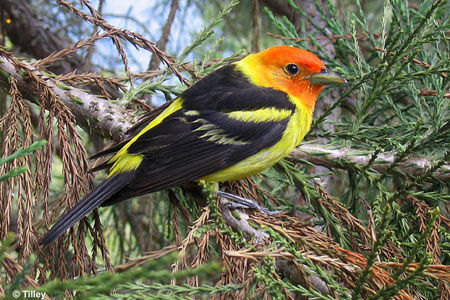The beautiful Western Tanager lends bright colors to the coniferous forests and oak woodlands of western Canada, and in the western USA from Washington and Montana to New Mexico and the Davis Mountains of Texas.
A common bird in much of its range, in western woodland habitats, the husky caroling song and sharp call notes of this pretty tanager are an essential part of the avian soundscape.
This species spends much of its time in upper levels of the forest where it forages for insects and fruit.
On this page
Identification
The Western Tanager is a small to medium-sized, somewhat stocky bird that usually frequents the canopy of western woodlands and forest. On occasion, it descends to bushes where the male’s striking combination of yellow, reddish-orange, and black is better appreciated.
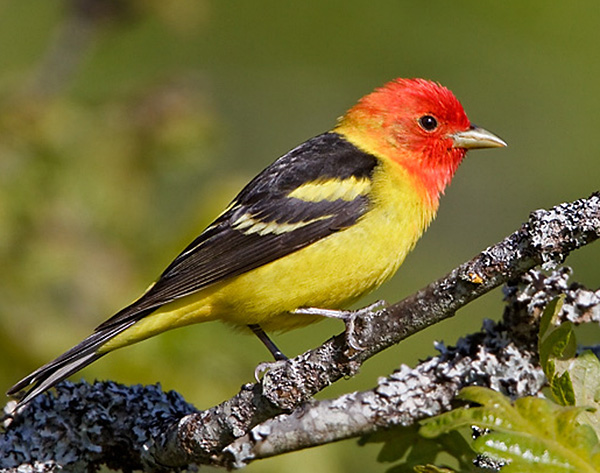
Male Western Tanager (Piranga ludoviciana) perched on a branch in Victoria, BC, Canada.
In spring and summer, the male has a distinctive reddish-orange color on the head, bright yellow body and rump, and black back, and tail. The rather long wings are also black but have a yellow patch on the shoulder, a broad white wing bar, and white edging to the feathers on the back part of the wing (these feathers are called tertials).
The female shows a similar pattern but lacks the reddish coloration on the head, tends to be more olive-colored than bright lemon yellow and has much duller colors overall.
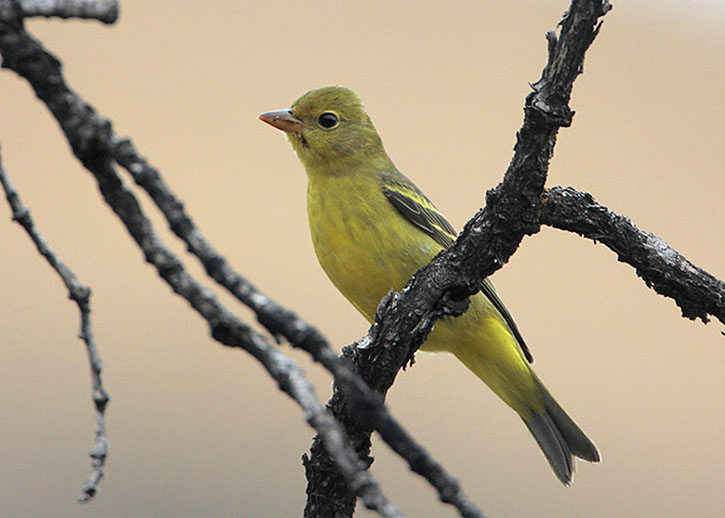
Female Western Tanager
The female also tends to show a more obvious narrow yellow eye-ring than the male. Both male and female birds can be recognized by their distinctive, somewhat stout, grayish or yellowish colored bill, and olive or yellow underparts combined with dark wings that have one yellow wing bar and one white wing bar.
Male and female Western Tanagers are very similar in shape and size, but the male tends to be slightly larger.
On their wintering grounds in Mexico and western Central America, males usually lack the reddish color on the head but still have bright yellow and deep black plumage.
The male Western Tanager has a song of several brief burry phrases, whereas the female doesn’t sing at all. However, both sexes often give a sharp, double or triple noted, rising call, “chidi-DEEP!”
Food
On their breeding grounds, insects make up the main part of the diet of the Western Tanager. To catch insect prey, tanagers carefully and deliberately move through the upper levels of trees to pick beetles, wasps, termites, and various other bugs from foliage, flowers, and other types of vegetation.
They also frequently catch insects by watching for a bug to fly within range of their perch and then making a short sally to snatch it from the air.
Quite often, especially after breeding, both male and female Western Tanagers visit Mulberry trees, Cherries, and other types of trees and bushes to feed on berries and other fruits.
On their breeding grounds, this species has also been seen feeding on egg shells and other scraps of food at timber camps, as well as following a lawnmower to catch insects near the ground. However, the majority of their foraging takes place in the foliage of tall trees, especially Douglas Fir and, in some places, in poplar and aspens.
On their wintering grounds, Western Tanagers have a similar diet, although they take much more fruit, are often found in small flocks, and can also spend more time foraging in low bushes.
Nesting and Eggs
From mid-May to early June, the Western Tanager builds a small to medium-sized, rather unkempt, cup-shaped nest in the fork of two branches.
It is usually placed from eight to thirty-five feet above the ground, and the female constructs and partly weaves the nest with sturdy twigs and rootlets, and occasional pieces of bark and other types of vegetable matter.
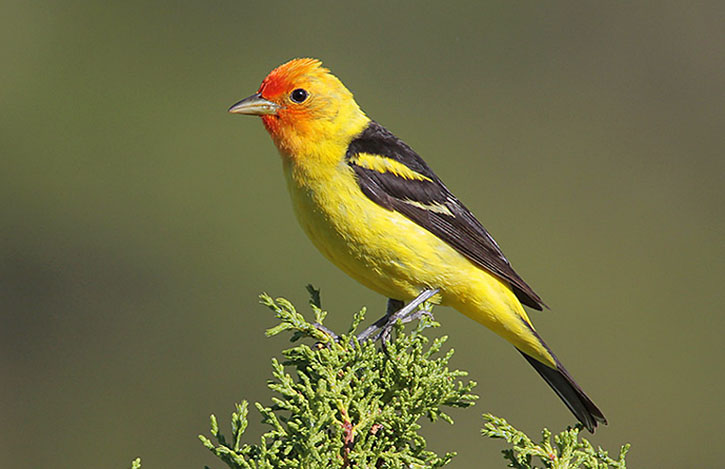
Female Western Tanager lines the nest with hair and soft rootlets. The nest is often constructed in a conifer, but various other tall trees can also be used. The nest has a diameter of 5.1 inches and is just a bit more than one inch deep.
The Western Tanager lays a clutch of three to five, but typically four, blue-gray eggs with a ring of small reddish-brown spots near the rounded end of the egg.
The eggs weigh 3.35 grams, and the female broods them for eight to thirteen days. At this time, the male only visits the nest to feed the female but also stays nearby to sing and protect its territory.
After the eggs hatch, both male and female birds feed the young, females giving them regurgitated food, and males bringing large insects. The male bird often brings dragonflies and will crush insect prey with its bill before giving it to the baby birds.
Current Situation
During the summer, the Western Tanager frequents a variety of woodland habitats, including coniferous forest, oak woodlands, aspen groves, and pinyon-juniper forests from the southern part of the Northwest Territories in Canada south to central Manitoba and most forested regions of the western United States east to the Rocky Mountains and the Davis Mountains of western Texas.
Although they are birds of forested areas while breeding, during migration, the Western Tanager can occur in a variety of additional habitats, including gardens with tall trees.
In the winter, this species uses a variety of coniferous and dry tropical forest habitats from parts of Chihuahua, Mexico south to the Pacific slope of Central America, including western Costa Rica, and, occasionally, western Panama.
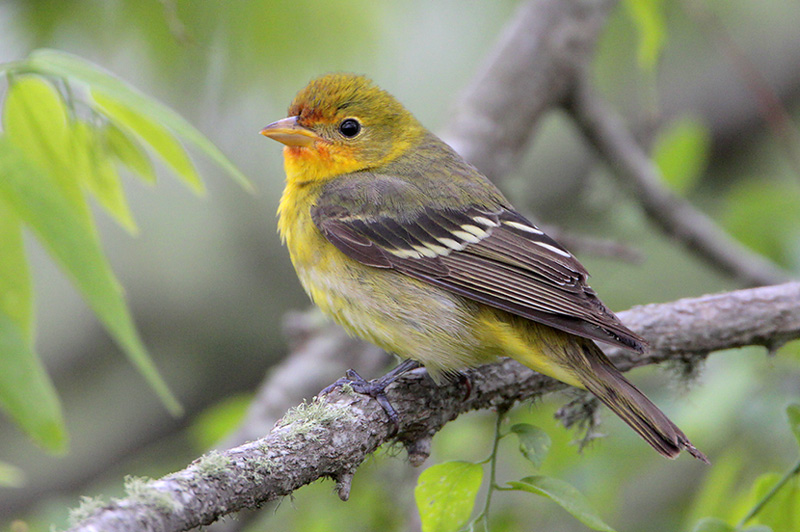
The Western Tanager is a common species and not considered to be endangered. In all likelihood, this pretty bird is doing well partly because it may tolerate selective logging and can thrive in a variety of forest and woodland habitats on both breeding and wintering grounds.
Facts
- The distinctive reddish-orange color on the head of the male Western Tanager comes from a pigment called, “rhodoxanthin.” It probably acquires this rare pigment from the insects it feeds on.
- Cut oranges can be used to attract this fruit loving bird to feeders. Fruiting trees planted in backyards can also attract them.
- Long before the Western Tanager and other birds were given legal protection, in an attempt to protect cherries and other fruit crops, fruit growers in California killed hundreds of these birds. Fortunately, it is now illegal to kill this beautiful bird species.
- The Western Tanager and other species in Canada and the USA that have “tanager” in their names actually pertain to the same family as the Cardinals and Grosbeaks. Although they have similar bright colors, they are not in the same family as the tanagers of Central and South America.
Similar Species
The Western Tanager has a distinctive plumage and appearance that separates it from most species in its range. However, there are four or five other birds that can be potentially confused with this species.
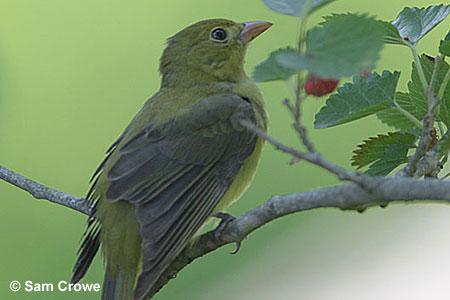
Female Scarlet Tanager
Female and winter-plumaged Scarlet Tanagers can look similar to Western Tanagers, but they never show wing bars.
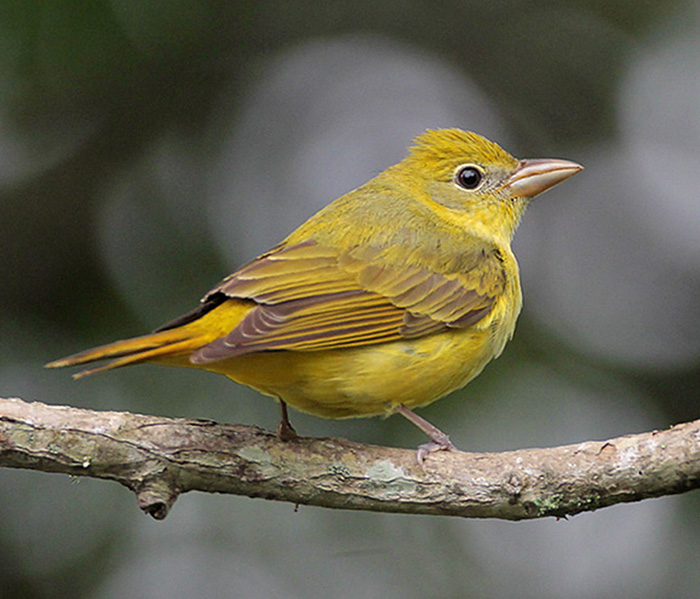
Female Summer Tanager
Summer Tanagers also have a similar shape and females can have olive-yellow plumage similar to that of the Western.
They lack prominent wing bars, do not have dark or blackish wings, and have a larger bill.
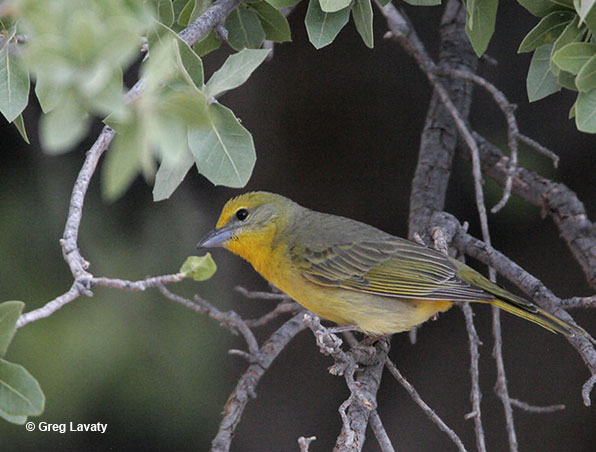
Female Hepatic Tanager
The female Hepatic Tanager is also somewhat similar to the female Western Tanager but lacks wing bars and has more uniform olive coloration.
Frequently Asked Questions
Is it rare to see a Western Tanager?
No, not in its breeding range of western Canada and the USA. However, it is rare to see Western Tanagers east of the Rocky Mountains.
What is the sound of Western Tanager?
The male Western Tanager sings a set of brief, burry phrases. Both male and female Western Tanagers make a sharp “chidi-DEEP!” call.
Do Western Tanagers eat bees?
Yes, bees make up a regular part of the diet of the Western Tanager.
What do Tanagers symbolize?
Tanagers symbolize the warm summer months and happiness.

